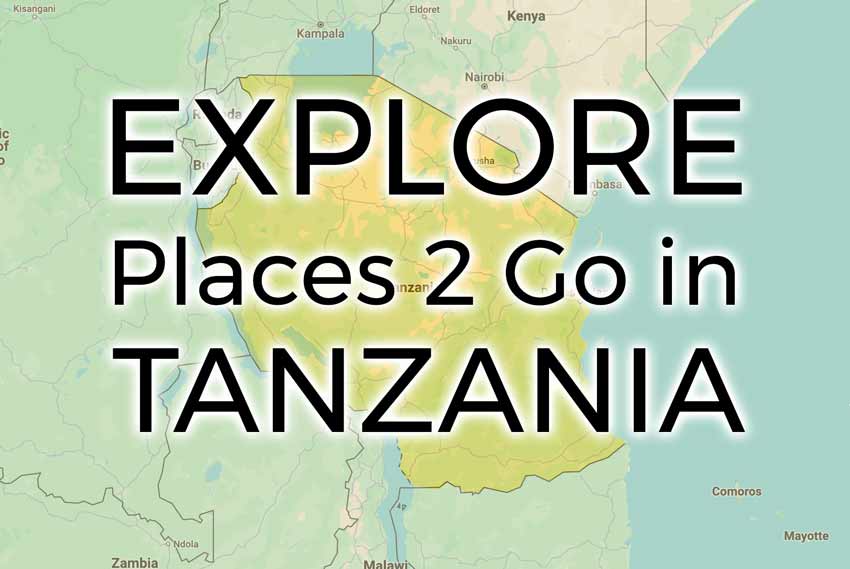Description: Isolated, untouched and with few visitors, Katavi is a true wilderness, providing a taste of the untouched Africa.
As Tanzania’s third largest national park it would attract large numbers of visitors, but it is in the remote Southwest part of Tanzania and difficult to reach. It is best to visit during the dry seasons (June through October) when water is scarce and for miles along the Katuma River, animals congregate in unbelievable numbers.
Towards the end of the dry season, up to 200 hippos might gather in one place and as more gather, the male rivalry heats up with ferocious territorial fights.
Location: Western Tanzania, reachable only with shared
Things 2 Do: Game Drives, Walking Safari, Fly Camping
Time: Stay at least 3 or 4 nights. Go in dry seasons: June to October and late-December to early March.
Animals: Thousands of Elephants, several herds of 1000-plus Buffalo and an abundance of Giraffe, Zebra, Impala, Hippos and Reedbuck, not to mention the numerous Lion prides and Spotted Hyena clans.
Accommodations
$
Chief Nsalamba Rest House
$$
Katavi Wildlife Camp
Mbali Mbali Katavi Lodge
$$$$
Chada Katavi
Katavi National Park Safari – The Untamed Wilderness of Tanzania
What draws travelers to remote corners of the world, far from the well-trodden paths of mass tourism? For many, the answer lies in the pursuit of authenticity; a chance to witness nature in its raw and untamed form. Katavi National Park in western Tanzania delivers exactly that. Unlike many parks that bustle with safari vehicles, Katavi remains an untouched wilderness, offering travelers a rare opportunity to immerse themselves in the rhythms of wildlife away from the crowds.
Introduction to Katavi National Park Safari
Katavi National Park is Tanzania’s third-largest protected area, yet it receives only a fraction of the visitors compared to Serengeti or Ngorongoro. Its remote location in the southwest ensures that those who embark on a Katavi National Park safari are rewarded with exclusivity and solitude. The experience is nothing short of exceptional, as herds of buffalo numbering in the thousands roam freely, lions patrol the open plains, and elephants gather in astonishing numbers along dwindling water sources during the dry season.
Why Katavi National Park is Unique
A Katavi safari is about raw wilderness and sheer abundance. During the dry months of June to October, the Katuma River becomes the lifeline of the park. Animals converge here in staggering numbers, creating scenes that feel almost primeval. Hippos squeeze into shallow pools by the hundreds, leading to dramatic territorial battles among males. Crocodiles dig tunnels into riverbanks to keep cool, while predators like lions and hyenas take advantage of the concentrated prey.
The vast open plains, dotted with palm trees and seasonal lakes, add to the park’s dramatic setting. Unlike more visited reserves, the safari experience here is uninterrupted; days can pass without encountering another vehicle, amplifying the sense of true wilderness.
Location and Accessibility
Katavi lies in western Tanzania, a region far from the bustling safari circuits of the north. Its remoteness contributes to its exclusivity, but it also means reaching the park requires planning. The most practical way is via scheduled or charter flights from Arusha, Dar es Salaam, or Ruaha. Shared flights are available, but the effort to get here is part of what makes a Katavi safari so rewarding. Once you arrive, the reward is clear; an endless horizon teeming with wildlife and virtually no interruptions from other travelers.
Best Time to Visit Katavi National Park
Timing is key to enjoying the best Katavi National Park safari. The park is most spectacular in the dry season between June and October. During this time, water sources diminish, and the Katuma River becomes a magnet for wildlife. The drama of predator and prey interactions plays out daily along its banks. Another good time to visit is between late December and early March, when the landscapes are lush but still accessible.
The rainy season, from March to May, makes travel difficult, and camps may close. Visitors planning a safari here should allow at least three to four nights to fully appreciate the park’s scale and richness.
Wildlife Encounters on a Katavi Safari
The wildlife density in Katavi is astonishing. Thousands of elephants roam its plains, creating unforgettable encounters. Massive herds of buffalo, sometimes numbering more than a thousand individuals, are among the most iconic sights of a Katavi safari. These herds are often trailed by predators, including numerous lion prides and clans of spotted hyenas.
Giraffe, zebra, impala, reedbuck, and topi add variety to the herds, while the birdlife is equally diverse. Hippos provide some of the park’s most memorable spectacles, gathering in unbelievable concentrations as the dry season intensifies. These gatherings often lead to noisy and dramatic confrontations that can last for hours.
Activities to Experience in Katavi
A Katavi National Park safari goes beyond traditional game drives. Walking safaris are particularly rewarding here, allowing visitors to connect deeply with the environment while guided by experienced rangers. Fly camping; spending the night under the stars with minimal setup; offers an unmatched sense of adventure in the wild.
Game drives remain the centerpiece of a Katavi safari, as they allow exploration of the varied habitats, from open floodplains to miombo woodlands. Each drive feels like a private journey into a land untouched by time.
Safari Accommodations in Katavi National Park
Despite its remoteness, Katavi offers a range of accommodation options, from budget-friendly government rest houses to luxury camps designed for comfort and seclusion.
- Chief Nsalamba Rest House ($): A simple option for travelers seeking a budget stay close to nature.
- Katavi Wildlife Camp and Mbali Mbali Katavi Lodge ($$): Mid-range camps that provide excellent comfort while still keeping the wilderness close.
- Chada Katavi ($$$$): A luxury tented camp renowned for its exceptional setting and immersive safari experiences.
Whether you seek simplicity or indulgence, the accommodations here blend seamlessly with the natural surroundings, ensuring an authentic safari atmosphere.
How Many Days Are Ideal for a Katavi Safari?
Given the distance and richness of experiences, a Katavi National Park safari should ideally last at least three to four nights. This allows enough time to explore the varied habitats, witness the dramatic wildlife spectacles, and savor the park’s atmosphere without rushing. Many travelers also combine Katavi with Mahale Mountains National Park, home to wild chimpanzees, for a truly extraordinary journey.
Why Choose Access 2 Tanzania for Your Katavi Safari
Planning a Katavi National Park safari requires expertise due to its remoteness and logistics. Access 2 Tanzania specializes in creating personalized safari itineraries that ensure you make the most of this exceptional destination. From flights and accommodations to expert guides and tailored safari experiences, we handle every detail so you can focus on the adventure.
Our team has years of on-the-ground knowledge, ensuring that your Katavi safari is not just a trip but an unforgettable immersion into one of Africa’s last true wilderness areas.
FAQs about Katavi National Park Safari
Q1: What makes Katavi National Park different from other parks in Tanzania?
Katavi’s remoteness means fewer visitors, giving you a safari experience with little to no crowding. Its massive herds of buffalo and elephants, along with dramatic hippo gatherings, make it unique compared to more visited parks.
Q2: How do I reach Katavi National Park?
The park is best accessed by air through scheduled or charter flights from Arusha, Dar es Salaam, or Ruaha. Road travel is possible but long and challenging, making flights the preferred option for most travelers.
Q3: When is the best time for a Katavi National Park safari?
The dry season, from June to October, is ideal as wildlife congregates around the Katuma River. Late December to early March is also good for lush scenery and rewarding sightings.
Q4: How many days should I spend in Katavi?
A stay of at least three to four nights is recommended to fully appreciate the park’s vastness, observe its unique wildlife behavior, and enjoy multiple activities without feeling rushed.
Q5: What wildlife can I expect to see in Katavi?
Expect huge herds of buffalo, elephants, giraffes, zebras, and impalas. Lions and hyenas are common predators, and hippos provide some of the most memorable spectacles, especially during the dry months.
Q6: Are walking safaris safe in Katavi?
Yes, walking safaris in Katavi are conducted by trained guides and armed rangers. Safety is prioritized, and the experience allows for a closer connection to the wilderness.
Q7: Can Katavi be combined with other safari destinations?
Absolutely. Many travelers combine Katavi with Mahale Mountains National Park to experience both big game safaris and chimpanzee trekking, creating a diverse and unforgettable safari adventure.
“We were very pleased with Access 2 Tanzania! From our first communications with Karen, to all the details that made our trip a success, to our awesome guide, Noel, to our interactions with other team members, Access 2 Tanzania made planning & then going on this trip a resounding success! We couldn’t have felt more comfortable with a tour operator than we did with Access 2 Tanzania.”


